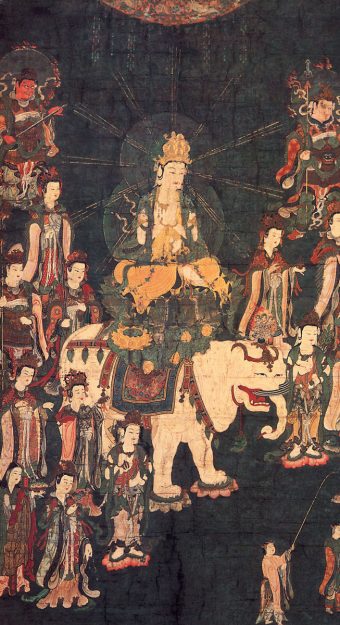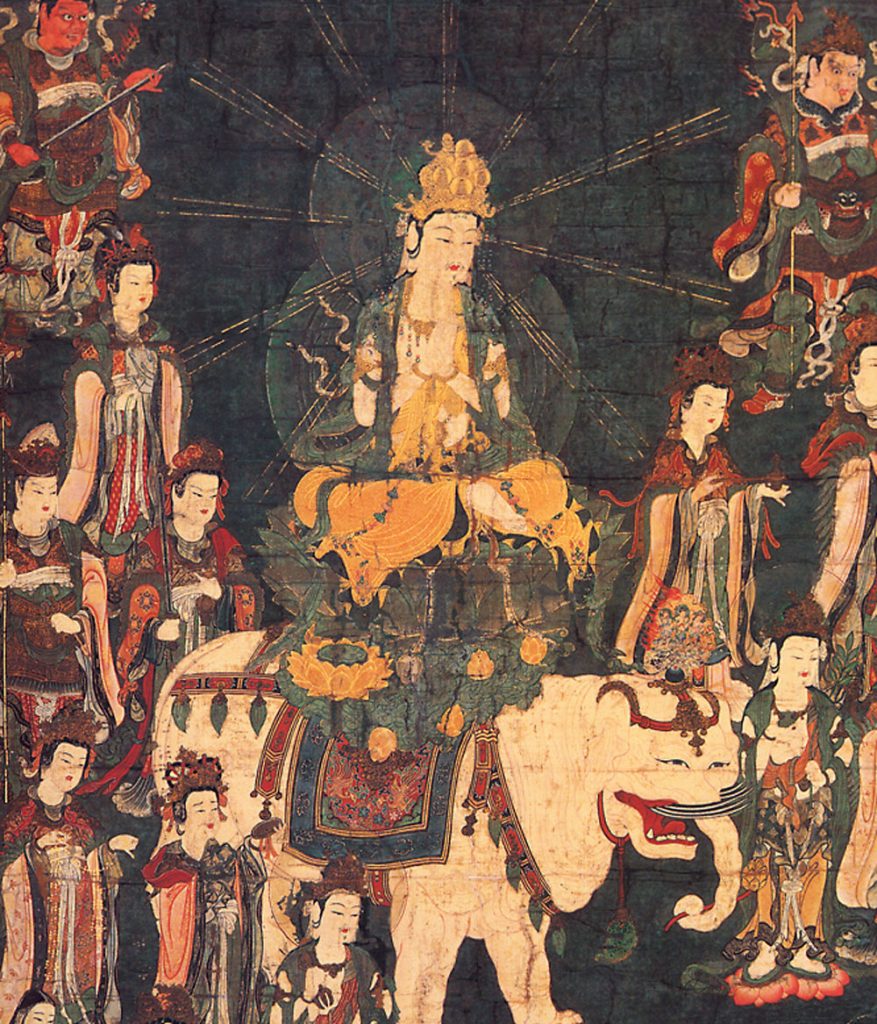Although I would not have described it as such at the time, looking back, I’d say that my first decade or so of Zen practice was focused on self-improvement, especially on discipline. I think I learned a lot, but most of what I learned centered on me—my strengths, my weaknesses, that sort of thing. During this time, I spent three years in monastic training at Tassajara Zen Mountain Center, and when I returned, I felt strangely adrift. I’d spent a lot of time examining and working on personal matters, but I was not particularly happy and in fact felt quite disengaged from my life. Something seemed to be missing from my practice. I began to wonder, Well, what now?
It was at this time that I took up an intensive study of the Lotus Sutra. I couldn’t really have explained why I was so drawn to the sutra, at least not at first. I was not clear about it myself. After a while, though, I came to see that the sutra was for me less a text than it was the actual arena of my life. Studying the sutra opened up my sense of practice. Practice was not just about me. The realm of practice conveyed by the Lotus includes everyone and everything. That sense of including all things—that was what was missing.
In East Asia, the Lotus Sutra has long been considered the king of sutras. The contemporary Vietnamese Zen master Thich Nhat Hanh echoes this perspective when he describes it as “the most beautiful flower in the garden of Mahayana Buddhist Sutras.” In the introduction to his translation of the Lotus, W. E. Soothill writes: “From the first chapter we find the Lotus Sutra to be unique in the world of religious literature. A magnificent apocalyptic, it presents a spiritual drama of the highest order, with the universe as its stage, eternity as its period and Buddhas, gods, men, devils as the dramatis personae.” With its enormous scale, its wondrous events, its lavish language, the sutra expresses Buddhism’s vision of compassion with singular power. In fact, its power to inspire can even become a problem, evoking not just faith but a kind of intoxication. So we should approach it with both openness and care.
For many Western Zen students and students of other meditative paths, the study of sutras, including the Lotus, may seem a bit strange. We recall Bodhidharma’s description of Zen as a “special transmission outside the scriptures.” We are familiar with the iconic story of Hui Neng setting fire to the scriptures. We are told not to rely on “words and letters.” So we tend to be suspicious of sutra study, thinking of it as an intellectual distraction from what is essential in practice. There is some truth to this, but it is only half the story.
The other half is that the study of sutras has always been an integral part of Buddhist practice. This is certainly the case with Zen, especially when it comes to the Lotus Sutra. In his own writings, Eihei Dogen, the founder of Japanese Soto Zen, quoted from the Lotus more than from any other text. In his masterwork, Shobogenzo (Treasury of the Eye of the True Dharma), he cites the Lotus extensively, even drawing from it the titles of some chapters. The chapter title “Butsu yo Butsu” (“Buddha and Buddha”) refers to the sutra’s claim that “only a Buddha together with a Buddha can fathom the reality of all existence.” In the chapter “Hokke ten hokke” (“the Lotus Turns the Lotus“), Dogen asks, “Do you turn the Lotus Sutra , or does the Lotus Sutra turn you?” In other words, he is telling us not to be pushed around by the sutra. Don’t take the sutra to be an object separate from yourself. Rather, become the sutra, and by doing so, you demonstrate its meaning directly.
The eighteenth-century Zen master Hakuin Ekaku is considered the father of modern Rinzai Zen, and his koan “What is the sound of one hand?” is one of the most famous. He also organized hundreds of traditional koans into the system that is used even today in Rinzai training. Hakuin’s association with koan study is deep and well known, far better known than his profound engagement with the Lotus Sutra. But the Lotus was crucial for Hakuin. He wrote about his struggles with the sutra, telling how his doubt and disappointment with it gave way to the realization that it was in fact a “perfect record” of the Buddha-dharma. One night, he writes, as he sat studying the Lotus, the chirping of a cricket occasioned an experience of kensho, or sudden illumination, in which he penetrated deep into the sutra’s meaning and all his doubts were completely resolved.
The Lotus Sutra is vast and difficult to grasp, like the mind of a Buddha. We don’t find in it, as we do in many other sutras, a systematic explication of a theme. Like a force of nature, the Lotus cannot be tamed to meet our designs. This can make for problems when one tries to teach it.

Shunryu Suzuki Roshi, the founder of San Francisco Zen Center and of Tassajara, tried several times to give a series of lectures on the Lotus. He never made it through. He would start talking about who was present—the various Buddhas, bodhisattvas, gods, mythological creatures, disciples, and so forth—and pretty soon it would be time to end the lecture. In the following lecture, he would start again, and the same thing would happen. But maybe that was enough.
When I first took up the study of the Lotus, I kept looking for its explicit message. I never found it. This is not to say that the sutra has no teachings. In fact, it abounds with teachings, about how Buddhas use various skillful means to lead beings to liberation, about how all beings have the capacity to attain Buddhahood, about the power of faith in the Buddha, about the beginningless nature of the enlightened mind, and so forth. But all this is presented not as the actual teaching of the Lotus Sutra but as a kind of preparation for hearing it. I wondered why the text goes on and on setting the scene for the preaching of the sutra but never seems to actually get to it. Eventually it dawned on me that the text is drawing you into an experience. It is putting you right there, practicing with countless others in the presence of the Buddhas. That is the message.
When I lecture on the Lotus Sutra , I usually begin with the koan “Manjushri Enters the Gate,” the first case from the classic collection The Iron Flute. In Buddhist mythology, the bodhisattva Manjushri is the embodiment of wisdom, and a statue of him sits atop the main altar in Zen Buddhist meditation halls. In the koan, the Buddha calls to Manjushri, who is standing outside the temple gate, “Manjushri, Manjushri, why don’t you enter?” Manjushri answers, “I don’t see a thing outside the gate. Why should I enter?”
I like Manjushri’s answer, but it seems a bit disingenuous. He is saying he does not discriminate between inside the gate and outside. But still he chooses not to enter. So I think he does see a difference. Maybe he should accept the Buddha’s invitation to enter the temple. Truly entering the gate—truly connecting to the Buddha’s teaching—is to directly experience that there is no inside and outside. This is not just an idea: you can’t understand it from the outside. Having entered, though, don’t think you are inside and others are still outside. Everyone enters with you.
Entering the gate means entering your life. Entering the Lotus Sutra means entering your life. This is practice. Practice means allowing the Lotus Sutra to enter you. To practice this way is to risk having your understanding of things overturned, again and again. This takes faith, faith enough to risk faith itself. So we have a choice. We can complacently watch life from the sidelines, or we can risk our pride, our ideas, and whatever else we use to separate ourselves from others and leap fully into our life. Take that leap and you will find the Lotus Sutra wherever you go.
♦
This article is a part of the special section on the Lotus Sutra in Tricycle’s Spring 2006 issue. The other articles in this section are:
“A Greater Awakening”
by Jan Nattier
“The Towering Assembly”
by Tricycle
“Single-Practice Masters”
by Tricycle
“The Lotus of the Wonderful Law”
by Andrew Cooper
“The Final Word: An Interview with Jacqueline Stone”
By Andrew Cooper
Thank you for subscribing to Tricycle! As a nonprofit, we depend on readers like you to keep Buddhist teachings and practices widely available.
